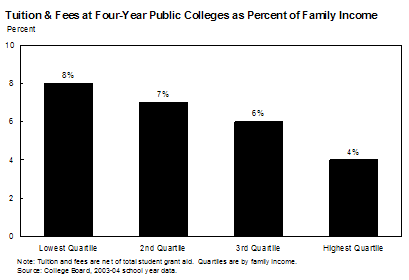
- Afghanistan
- Africa
- Budget Management
- Defense
- Economy
- Education
- Energy
- Environment
- Global Diplomacy
- Health Care
- Homeland Security
- Immigration
- International Trade
- Iraq
- Judicial Nominations
- Middle East
- National Security
- Veterans
- President's Cabinet
- USA Freedom Corps
- Faith-Based & Community Initiatives
- Office of Management and Budget
- National Security Council
- USA.gov
|
Home >
News & Policies >
Policies in Focus >
Economy & Budget
|
State of the Economy Overview
JANUARY 2007
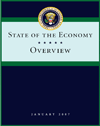
- The State Of The Economy
- Jobs: America's Workers Are Prospering
- Wages: Real Wages For American Workers Are Growing
- Taxes: The President's Tax Relief Is Benefiting All Income Taxpayers
- Trade: Opening New Markets Is Benefiting Americans
- Competitiveness: America Remains At The Global Economic Forefront
- Families: President Bush's Economic Policies Are Benefiting America's Working Families
The State Of The Economy
"A future of hope and opportunity begins with a growing economy – and that is what we have. … This economy is on the move, and our job is to keep it that way, not with more government, but with more enterprise.."– President George W. Bush, State Of The Union Address, 1/23/07
Today In New York, President Bush Delivered A Report On The State Of America's Economy. The President highlighted our strong and dynamic economy, and discussed the challenges we face in keeping the economy growing. The U.S. economy is resilient and responsive, adding more than 7.2 million jobs since August 2003 despite numerous challenges including a recession, corporate scandals, the 9/11 attacks, and the worst natural disaster in American history.
American Workers Are Finding Jobs And Taking Home More Pay
- Our Economy Has Created More Than 7.2 Million Jobs Since August 2003. Payroll jobs increased 167,000 in December alone, and have increased by more than 600,000 jobs in the past four months.
- The Unemployment Rate Was 4.5 Percent In December. This is well below the 5.1 percent average rate for 2005, and below the average of each of the past four decades.
- Real Wages Rose 1.7 Percent During 2006. This rate of growth is substantially faster than the average rate of the 1990s, meaning an extra $1,030 last year for the typical family of four with two wage earners.
- Real After-Tax Personal Income Per Person Has Increased Over $2,800 – Or 9.6 Percent – During This Administration.
The President's Agenda Will Help Keep The American Economy Flexible And Dynamic
- Making Tax Relief Permanent: The President reduced taxes for every American who pays income taxes, and calls on Congress to keep our economy growing by making this tax relief permanent.
- Balancing The Budget: President Bush has proposed balancing the budget through pro-growth policies and spending restraint, enacting common-sense reforms to help prevent billions of taxpayer dollars from being spent on unnecessary earmarks, and reforming entitlement programs.
- Extending Trade Promotion Authority: The President believes the best way to expand opportunity for American workers and help impoverished nations is to encourage free and fair trade, and he has asked Congress to extend his trade promotion authority to negotiate trade deals.
- Reforming Our Health Care System: In addition to his ongoing policies, the President's State of the Union Address included new initiatives to help make health care available and affordable for more Americans, including a standard deduction for health insurance and the Affordable Choices Initiative for States.
- Diversifying Our Energy Supply: By increasing the transportation sector's energy diversity and reducing demand for oil, the President's Twenty in Ten energy plan announced in his State of the Union Address can enhance America's energy security and help confront the challenge of climate change.
- Strengthening Public Education: The President's proposals to strengthen and reauthorize the No Child Left Behind Act will help ensure that every public school is a place of learning and a force for upward mobility. In addition, the President's American Competitiveness Initiative will help improve math and science education in middle schools and high schools.
America's Business Leaders Also Have Responsibilities. Shareholders should know what executive compensation packages look like, so the Securities and Exchange Commission has issued new rules to ensure that these packages are transparent. Government should not decide compensation for America's corporate executives, but the salaries and bonuses of CEOs should be based on their success at improving their companies and building value for their shareholders.
Making Tax Relief For All Americans Permanent
Through The End Of 2006, President Bush's Tax Relief Has Helped Spur Economic Growth By Keeping $1.1 Trillion In The Pockets Of American Taxpayers. The President reduced taxes for every American who pays income taxes, doubled the child tax credit, reduced the marriage penalty, created new incentives for small businesses to invest, and put the death tax on the road to extinction. The American people have used the tax relief to provide for their families, create jobs, and help make America's economy the envy of the industrialized world.
- The President Calls On Congress To Keep Our Economy Growing By Making His Tax Relief Permanent. To keep our economy growing, the President wants to make tax rate reductions and other pro-growth tax relief permanent. He also supports making permanent the Child Tax credit and the marriage penalty relief.
- In May 2006, The President Signed The Tax Increase Prevention And Reconciliation Act Of 2005, Extending His 2003 Tax Cuts On Dividends And Capital Gains. In December 2006, the President signed legislation to extend the deductibility of tuition and higher education expenses to help more Americans go to college, and to extend and expand the research and development tax credit to keep our Nation leading the world in technology and innovation.
Balancing The Budget By 2012
Next Week, President Bush Will Propose A Budget That Will Reduce The Deficit Over The Next Five Years And Produce A Balanced Budget By 2012. The Budget will achieve balance while addressing the Nation's most critical needs, including supporting the Global War on Terror and sustaining the strength of our economy through permanent tax relief.
- The President Has Called For Earmark Reform To Help Eliminate Wasteful Spending. The President applauds Congress' progress in requiring the disclosure of the sponsors, costs, recipients, and justification for each earmark. The President calls on Congress to go further by enacting comprehensive earmark reform that brings greater transparency and accountability to the Congressional budget process, including:
- Stopping the practice of concealing earmarks in so-called report language instead of placing them in the actual language of the bill.
- Cutting the number and cost of all earmarks at least in half by the end of this session.
- The President Believes Balancing The Budget Through Pro-Growth Economic Policies And Spending Restraint Better Positions Us To Tackle The Longer-Term Fiscal Challenge Facing Our Country: Reforming Entitlements. Reforming Social Security, Medicare, and Medicaid will enable future generations to benefit from these vital programs without bankrupting our country. The President has led the way in focusing attention on this problem and in promoting real solutions, and passing legislation to enact such reforms will require bipartisan cooperation.
Extending Trade Promotion Authority
The President Is Committed To Opening Markets Around The World And Expanding Opportunities For America's Farmers, Ranchers, Workers, And Businesses. America is home to 5 percent of the world's population, meaning that 95 percent of our potential customers are abroad. President Bush believes America can compete economically with any nation as long as the rules are fair. By encouraging a system of free and fair trade, we can create better-paying jobs for American workers and farmers, provide new opportunities for entrepreneurs, and help lift entire nations out of poverty.
- The President Has Asked Congress To Extend His Trade Promotion Authority To Negotiate Trade Deals, Including The Doha Round. The President believes the best way to help impoverished nations and expand opportunity for American workers is to complete the Doha round and expand wealth and opportunity through opening markets and ensuring our trading partners play by the rules.
Reforming Our Health Care System
The President Seeks To Help More Americans Afford Basic Private Health Insurance By Reforming The Tax Code With A Standard Deduction For Health Insurance And Helping States Make Affordable Private Health Insurance Available To Their Citizens. The President's proposed standard deduction for health insurance will help make basic private health insurance more affordable for families and individuals – whether they have insurance through their jobs or purchase insurance on their own. For those who remain unable to afford coverage, the President's Affordable Choices Initiative will help eligible States assist the poor and sick in purchasing private health insurance.
- President Bush Has Called On Congress To Enact Other Policies To Help Make Health Care More Affordable And Accessible. We need to expand Health Savings Accounts, help small businesses through Association Health Plans, reduce costs and medical errors with better information technology, encourage price transparency, and protect good doctors from predatory lawsuits by passing medical liability reform.
Diversifying Our Energy Supply
The President's Twenty In Ten Energy Plan Sets The Goal Of Reducing U.S. Gasoline Usage By 20 Percent In 10 Years. This plan will help confront the challenge of climate change and increase our energy security by:
- Increasing The Transportation Sector's Energy Diversity. Under the President's proposal, the alternative fuel standard will be set at 35 billion gallons of renewable and alternative fuels in 2017, an amount equal to 15 percent of projected annual gasoline consumption. Increasing renewable and alternative fuels used in automobiles from 3 percent in 2006 to 15 percent in 2017 can give drivers a built-in defense against supply disruptions and high gasoline prices.
- Reducing Oil Demand. Reforming and modernizing fuel standards for cars as we did with light trucks will reduce projected gasoline consumption by another 5 percent in 2017. Overall, the President's plan will reduce our projected gasoline consumption by 20 percent in 2017. Reducing oil demand could slow the growth of oil prices and lower price volatility over time, increasing our energy security.
In Addition, The President Has Called For Doubling The Current Capacity Of The Strategic Petroleum Reserve To 1.5 Billion Barrels By 2027. Uninterrupted oil supply is critical to our energy security. Increasing oil reserves strengthens our ability to respond to supply disruptions and reduces our vulnerability to terrorist attacks on energy supplies and infrastructure.
Keeping America Competitive By Strengthening Education
The President's American Competitiveness Initiative (ACI) Will Help Keep America The Most Innovative And Competitive Economy In The World. The ACI will encourage more aggressive investment by businesses in research and development, increase Federal support for vital basic research, and improve math and science education for America's students – as well as support the basic research that research that fuels innovation.
The No Child Left Behind Act Is Getting Results For Our Children And Our Economy – And The President Asks Congress To Reauthorize It This Year. Math and science skills are critical for success in college and the workplace. The President's proposals to strengthen and reauthorize NCLB include:
- Strengthening the teaching of math in elementary and middle schools by implementing the Math Now program based on the recommendations of the National Math Panel;
- Increasing academic rigor by training more teachers and making rigorous Advanced Placement classes available to more low-income students;
- Encouraging talented professionals, especially in the fields of math and science, to share their expertise in the classroom through the Adjunct Teacher Corps; and
- Encouraging a greater focus on science by including student achievement results in science in accountability decisions.
In February 2006, The President Signed Legislation Creating Grants To Encourage Students To Complete A Rigorous High School Course Of Study And To Major In Math, Science, Or Critical Foreign Languages. Academic Competitiveness Grants and National SMART Grants will provide $4.5 billion over the next five years to further reward Pell-eligible students who complete a rigorous high school curriculum or who pursue college majors in high demand.
Funding For Pell Grants Has Risen By Nearly 50 Percent Since President Bush Took Office. More students received aid last year than in any other year. From 2001 to 2006, student aid funding increased by 57 percent, and the number of students receiving aid increased by 24 percent.
- Student Loan Interest Rates Are Low By Historical Standards. This school year, as required by 2002 legislation, the variable interest rate was replaced with a fixed 6.8 percent interest rate, which is lower than the student loan interest rate in all but six of the last 42 years.
Jobs: America's Workers Are Prospering
Since August 2003, More Than 7.2 Million Jobs Have Been Created – More Jobs Than The European Union And Japan Combined. January 2007 is expected to be the 41st month of uninterrupted job growth since recovery began in August 2003. (Bureau Of Labor Statistics, Including Benchmark Revision)
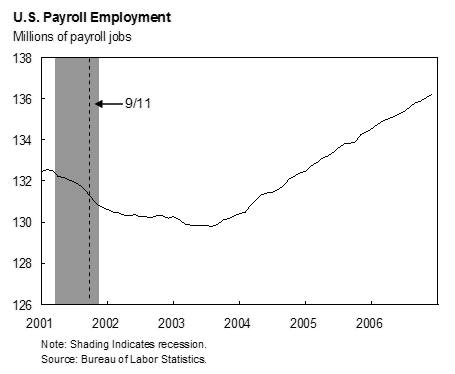
Real Wages Rose 1.7 Percent In 2006. This means an extra $1,030 for the typical family of four with two wage earners.
Real After-Tax Income Per Person Has Risen By 9.6 Percent – More Than $2,800 – Since President Bush Took Office.
America's Job Growth Has Been Broad-Based. Job gains were spread broadly across major sectors in 2006. Twenty-five percent of job growth within the service-providing sector was in health and education-related jobs. (Bureau Of Labor Statistics)
During 2006, Employment Increased In All But One State.
The National Unemployment Rate Remains Low At 4.5 Percent. This is well below the 5.1 percent average rate for 2005, and below the average of each of the past four decades.
Jobless Rates Are Down Among Most Major Groups. The unemployment rate dropped for each of the four educational-attainment groups, falling most among those without a high school degree. The jobless rate in this group fell 0.7 percentage point to 6.6 percent during 2006, and has fallen 1.5 percentage points over the past two years. The unemployment rate fell sharply during 2006 among Hispanics and blacks (1.1 and 0.9 percentage points, respectively). (Bureau Of Labor Statistics)
Hiring Rates And Voluntary Job Changes Are Higher Than Ever. In 2006, hiring in the nonagricultural sector (4.9 million per month) was at its highest pace since data collection began in 2001. The share of workers who left their job voluntarily was also the highest ever at 58.3 percent. (Bureau Of Labor Statistics)
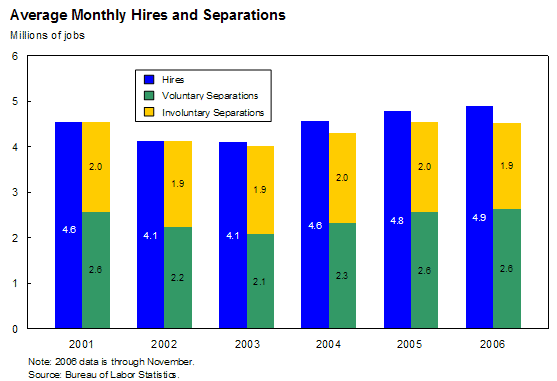
Workers Are Less Likely To Lose Their Jobs. The probability that a typical worker will get fired or laid off over the course of a month is now 1.1 percent, down from 1.3 percent in 2001. (CEA Calculation Based On Bureau Of Labor Statistics Data)
Workers Are Finding Jobs Faster. The median duration of unemployment declined during 2006, from 8.5 weeks to 7.3 weeks, close to its historical average. The number of long-term unemployed (those out of work for more than 26 weeks) fell by 263,000 during the year. (Labor Department)
More Opportunities Are Available For College Graduates. Employers reportedly plan to hire 17.4 percent more college graduates from the class of 2007 than they hired from the class of 2006. This is the fourth straight year of double-digit increases in college graduate hiring by employers. They also report starting salaries increased for most fields. (National Association Of Colleges And Employers)
A Broader Measure Of Unemployment Is Also Down. The percentage of workers who are either working part-time but seeking full-time employment or who are unemployed has decreased from 8.6 percent a year ago to 8.0 percent in December, matching its lowest level in over five years. (U-6 Unemployment From Bureau Of Labor Statistics)
The U.S. Economy Has Proven Resilient And Responsive. We lost nearly 1 million jobs in the three months following 9/11. Since then, the economy has added millions of jobs, and we now have more jobs than in 2000.
Fewer Workers Are Filing For Unemployment Benefits. The monthly average of initial unemployment insurance benefit claims was 318,000 per week in December, down more than 20 percent since August 2003. As a share of the labor force, this is below the historical average. (Labor Department)
More Jobs Are Going Unfilled. The seasonally-adjusted rate of job openings (job openings relative to total jobs plus job openings) was 3.0 percent in November – its highest level since early 2001 – with employers reporting over 4.2 million job openings, an increase of 53 percent since August 2003. (Bureau Of Labor Statistics)
Wages: Real Wages For American Workers Are Growing
Wages For Production Workers Are Growing Faster Than Inflation. Real hourly wages (base hourly wage rates plus commissions, overtime premiums, and bonuses) for production and non-supervisory workers (about 80 percent of the workforce) grew 1.7 percent over the past 12 months. The supervisory workers who tend to have above-average earnings are not included in this figure. (Bureau Of Labor Statistics)
Recent Real Wage Growth Means More Buying Power For Workers. The wage growth translates into an extra $585 for the average full-time worker and an extra $1,030 last year for a typical family of four with two workers. (Council Of Economic Advisers Analysis Of Data From Bureau Of Labor Statistics)
Annual Wage Growth Is Faster Now Than In The 1990s. The real hourly wage growth of 1.7 percent in the past 12 months is substantially faster than the annual average growth of 0.3 percent in the 1990s.
Wage Growth Now Is Stronger Than In The Previous Economic Expansion During The 1990s. The cumulative growth in real hourly wages during this economic expansion – from the recession until now – has also been 1.7 percent. At this same point in the 1990s expansion, wages had fallen by 0.4 percent. (Bureau Of Labor Statistics)
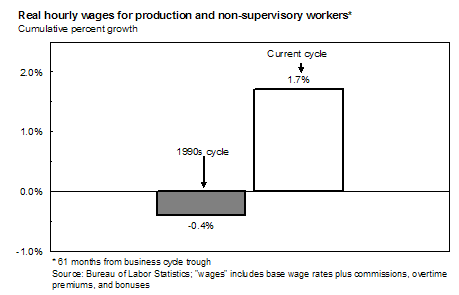
Other Earnings Measures – Including Real After-Tax Income Per Person – Also Show Strong Growth. Real after-tax personal income per capita has increased $2,850 (9.7 percent) since the end of the 2001 recession, but at this same point in the previous economic expansion in the 1990s, it had grown just 6.7 percent. Real compensation per hour has also been growing faster in the current economic expansion. (Bureau Of Economic Analysis)
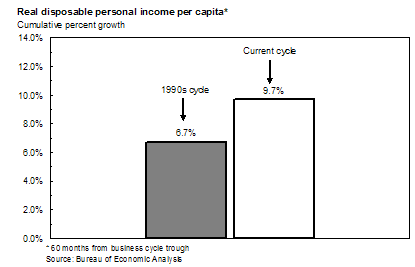
Education And Skills Make A Big Difference. Over the past 25 years, hourly wages have grown much faster for college-educated workers than for those with less education. Since 1978, median wages for high-school graduates have grown only 0.4 percent in real terms, while median wages for college graduates grew 22.7 percent. (Labor Department)
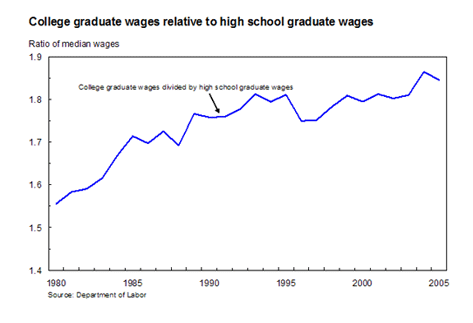
The United States Is A Mobile Society. About 20 percent of Americans in the bottom income quintile move up over one-year periods and about 40 to 50 percent move up within 10 to 20 years. (Treasury Department)
Education Increases Upward Mobility. According to a 2004 Census report that studied income mobility between 1996 and 1999, higher levels of education were associated with higher likelihoods of moving up the income distribution. (Census Bureau)
Taxes: The President's Tax Relief Is Benefiting All Income Taxpayers
President Bush's 2001 And 2003 Tax Relief Has Reduced Taxes For Every American Income Taxpayer. Tax relief enacted during the President's administration includes:
- Across-the-board tax rate cuts on personal income.
- Creation of low 10 percent tax bracket.
- Doubling of the child tax credit.
- Reduction in marriage penalty.
- Expanded incentives for small businesses to invest.
- Reduction of capital gains and dividends tax rates.
- Reduction of tax burdens on education, investment, and retirement saving.
The President's Tax Relief Enabled More Than 5 Million Taxpayers, Including 4 Million Taxpayers With Children, To Have Their Income Tax Liability Completely Eliminated In 2006. As a result of the President's tax relief, a family with two children now begins to pay income taxes when their income reaches $41,867. Without tax relief, the same family would have begun to pay income taxes when their income reached $33,070. (Treasury Department)
The Benefits Of The President's Tax Relief Are Widely Distributed. The increase in the child tax credit, creation of the 10 percent tax bracket, and reduction of the marriage penalty accounted for almost 60 percent of the tax relief in 2006. (Treasury Department)
The President's Tax Relief Is Helping Americans Keep More Of What They Earn. Through the end of 2006, the President's tax relief has kept $1.1 trillion in the pockets of American taxpayers. In 2007, 113 million taxpayers will see their taxes decline by an average of $2,216. (Treasury Department)
The President's Tax Relief Is Keeping The Tax Code Progressive. The share of taxes paid by the top 5 percent of taxpayers in 2006 will be 53.3 percent, compared to 51.6 percent without the tax cuts – an increase of 3 percent. The share of taxes paid by the bottom 50 percent of taxpayers will be 3.4 percent, and would have been 4.0 percent without the cuts — a decline of 15 percent. (Treasury Department)
The President's Tax Relief Is Benefiting All Americans Who Pay Income Taxes. Total effective Federal tax rates for all income quintiles declined between 2000 and 2004. The average tax rate for the entire economy fell from 23.0 percent to 20.0 percent in the same period. (Congressional Budget Office)
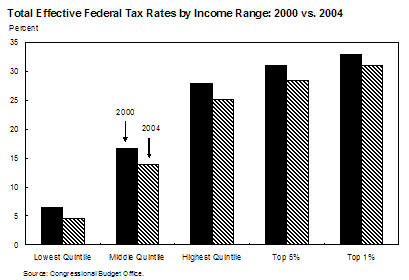
Over 40 Percent Of All Households Do Not Pay Income Tax. (Treasury Department)
Low-Income Families Are Receiving More Money Through Refundable Tax Credits. The President's tax relief has reduced the average Federal income tax rate from 2.9 percent for a family of four with half the median income in 2000 to a negative 4.7 percent in 2005 – meaning that the typical family with half the median income is receiving about $1,500 in transfers through the tax system. (Tax Policy Center)
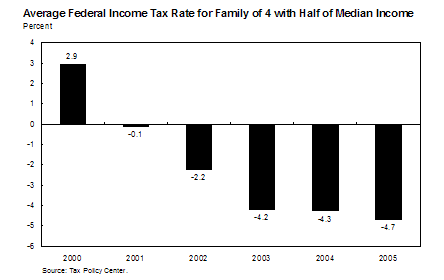
The President's Tax Relief Is Helping Spur Economic Growth. The President's tax relief has played an important role in strengthening the U.S. economy as it was coming out of the recession and in stimulating economic growth by increasing the after-tax rewards to work and saving. The annual growth rate in real GDP in the 13 quarters following passage of the Jobs and Growth Tax Relief Reconciliation Act of 2003 averaged 3.6 percent, compared to 1.1 percent in the 9 quarters preceding the Act's passage. (Treasury Department, Bureau Of Economic Analysis)
The President's Tax Cuts Have Been Followed By More Than 7 Million New Jobs. Since the President's tax relief became effective in 2003, there has been a sizeable increase in business investment, over seven million jobs created, and higher wages for American workers. (Treasury Department, Bureau Of Labor Statistics, Bureau Of Economic Analysis)
The President's Tax Relief Is Helping Boost Investment By Reducing The Effect Of Taxes On Capital Investment Decisions. Real private nonresidential investment increased by an average annual rate of 6.9 percent in the 13 quarters after passage of the Jobs and Growth Tax Relief Reconciliation Act of 2003, after declining by an average annual rate of 7.0 percent in the previous nine quarters. (Treasury Department, Bureau Of Economic Analysis)
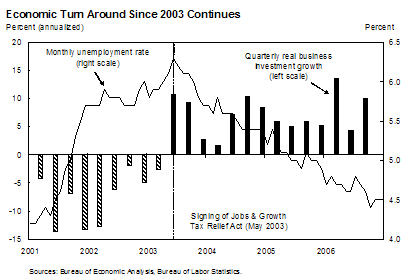
Without The President's Tax Cuts, The Economy Would Have Had As Many As 3 Million Fewer Jobs And Real GDP Would Have Been As Much As 3.5 To 4.0 Percent Lower By The End Of 2004. (Treasury Department)
Since The Tax Relief Was Fully Implemented In 2003, Tax Receipts Have Increased About 35 Percent. Federal receipts as a percent of GDP are at 17.5 percent, near the historical average of 18.0 percent. (OMB, Treasury Department)

Historic Revenue Growth And A Continued Commitment To Spending Restraint Helped Cut The Deficit In Half 3 Years Ahead Of The President's Goal. In addition, the President has announced he will propose a budget that continues to reduce the deficit over the next five years and produces a balanced budget by 2012.
Trade: Opening New Markets Is Benefiting Americans
Exports Are At A Record High – More People Around The World Are Buying American Products Than Ever Before. U.S. exports of goods and services over the first 11 months of 2006 totaled $1.3 trillion, and imports amounted to $2.0 trillion. The trade surplus in services over this period was $65 billion. (Bureau Of Economic Analysis)
Exports Are Helping Drive Economic Growth. In the last four quarters, real exports grew 9.1 percent – more than three times as fast as overall GDP. (Bureau Of Economic Analysis)
A Large Share Of U.S. Trade Occurs With Our Free Trade Partners. As of January 1, 2007, the 13 countries with which America has implemented free trade agreements account for just 7.3 percent of world GDP (excluding the U.S.). But our exports to these 13 countries account for more than 42 percent of U.S. exports. The 13 countries are: Australia, Bahrain, Canada, Chile, El Salvador, Guatemala, Honduras, Israel, Jordan, Mexico, Morocco, Nicaragua, and Singapore. Congress has approved agreements with three more countries – the Dominican Republic, Costa Rica, and Oman – and America has completed agreements with Peru, Colombia, and Panama which will require Congressional enactment. America continues negotiations with other trading partners across the globe. (CIA World Factbook, Census Bureau)
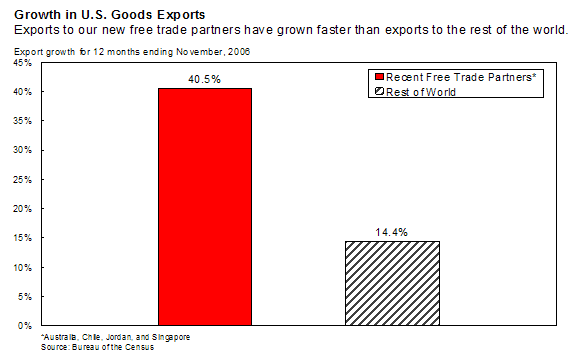
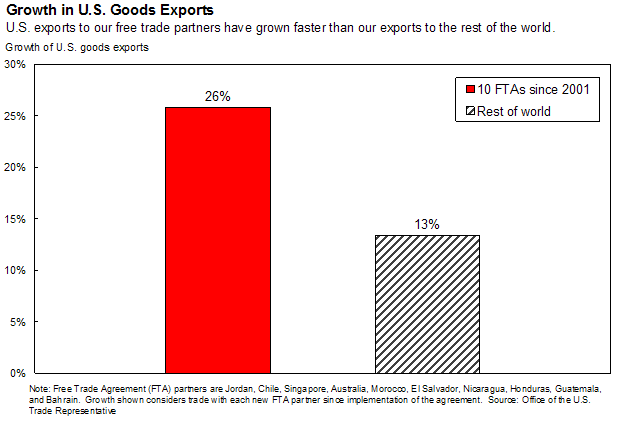
Opening New Markets Is Benefiting America's Economy, Consumers, And Working Families. Increased trade flows since World War II have resulted in income gains of about $9,000 for the average American household. (Institute For International Economics, "The United States and the World Economy," 2005)
- Further Reducing Trade Barriers Would Help Even More Americans. A number of barriers to trade remain, especially in services and investment, and the benefits of eliminating these barriers are significant. By encouraging a system of free and fair trade, we can create better-paying jobs for American workers and farmers and provide new opportunities for entrepreneurs.
- Research Shows Prospective U.S. Economic Gains From Full, Global Free Trade In Services Is Over $500 Billion In Annual U.S. Income. Most employment and economic output in the United States is in services. Research shows full, global free trade in services could lead to an additional $7,000 in annual income for the average American family of four. (Brown, Deardorff, and Stern, "Computational Analysis Of Multilateral Trade Liberalization In The Uruguay Round And Doha Development Round," RSIE Discussion Paper No. 489, 2002)
- The Market For U.S. Products Is Larger Than Ever Before. Ninety-five percent of the potential customers for U.S. goods and services live in other countries, and more than 70 percent of the world's purchasing power is outside the United States. (World Bank)
Companies Engaged In International Trade Employ A Large Share of U.S. Workers. Over 57 million American workers (42 percent of the civilian workforce) are now employed by a firm that engages in international trade. (Andrew B. Bernard, J. Bradford Jensen, and Peter K. Schott, "Importers, Exporters And Multinationals: A Portrait Of Firms In The U.S. That Trade Goods," NBER Working Paper No. 11404, April 2005)
American Workers Benefit From Inward Foreign Direct Investment. In 2004, nearly 5.1 million Americans worked in the U.S. affiliates of foreign-owned companies, at an average annual compensation of over $63,000 – 31 percent above the average of the rest of the U.S. private sector. Foreign direct investments in the U.S. were worth $2.8 trillion. (Bureau Of Economic Analysis, CEA Calculations Based On Bureau Of Labor Statistics)
U.S. Direct Investment Abroad Is An Important Channel Of Global Market Access For U.S. Firms. U.S. multinational firms rely more heavily on their foreign affiliates' sales than on direct exports to serve foreign markets. In 2004, for every $1 of exports in goods, U.S. multinational firms sold $5.84 of goods through their foreign affiliates. (Bureau Of Economic Analysis)
Between 1977 And 2000, U.S. Multinational Firms Accounted For Over Half Of U.S. Productivity Growth. They accounted for half of the increase in U.S. productivity growth between 1995 and 2000. During this five-year period, productivity at U.S. multinationals surged, growing 6.0 percent annually. (Corrado, Lengermann, and Slifman, "The Contribution Of MNCs To U.S. Productivity Growth, 1977-2000," Federal Reserve Board, 2003)
Competitiveness: America Remains At The Global Economic Forefront
Over The Past Year, America's Real GDP Has Grown By 3 Percent – The Fastest Rate Of Any Major Industrialized Country. America's unemployment rate is 4.5 percent – the second-lowest unemployment rate of any major industrialized country. (Bureau Of Labor Statistics, Bureau Of Economic Analysis, International Statistics Offices)
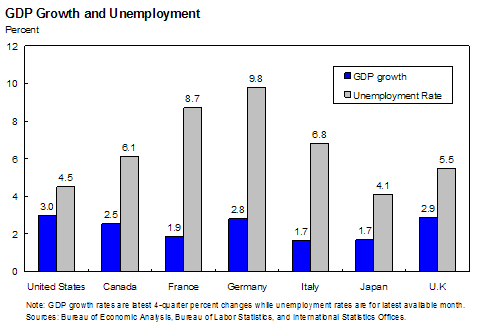
Rising Productivity Is Driving U.S. Competitiveness. The United States has experienced the fastest increase in productivity growth among major industrialized countries since the early 1990s, and U.S. productivity has accelerated during the past few years. From 2000 to 2005, U.S. productivity (measured as GDP per hour worked) grew at annual rate of 2.5 percent, compared to 2.2 percent between 1995 and 2000, and 1.2 percent between 1990 and 1995. Only the United States and Japan have had faster productivity growth in the most recent period than they did in the 1990s. (Organization For Economic Cooperation And Development)
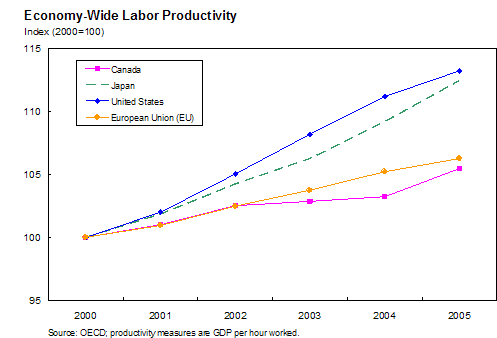
America's High Levels Of Education Make Our Workers More Competitive. Thirty-eight percent of Americans complete some form of higher education. In addition, for the first time in 30 years, the U.S. exclusively won four of last year's six Nobel prizes. (Organization For Economic Cooperation And Development)
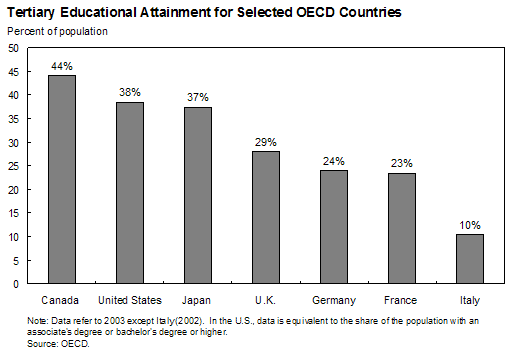
America's Business Environment Promotes Entrepreneurship. According to the 2006 World Bank "Doing Business" survey, the United States ranks third in the world for the fewest number of days required to start a business, at five days. Entrepreneurs in the U.S. also face the fourth-lowest administrative costs in the world. (World Bank)
America's Manufacturing Sector Remains Strong. The United States has the largest manufacturing sector in the world, and America's manufacturing sector alone would be the seventh largest economy in the world. Real growth in the U.S. manufacturing sector has outpaced the rest of the U.S. economy over the past four years.
A Recent Decline In American Manufacturing Jobs Reflects Global Trends, But American Manufacturing Companies Are Producing More With Fewer Employees. Productivity growth in the manufacturing sector has averaged 4.5 percent per year in the past 10 years, and has accelerated to 4.8 percent over the past five years. Over the past five years, every G-7 country except Italy has lost manufacturing jobs – with an average decline of over 12 percent. Over the past 50 years, real output in U.S. manufacturing has increased an average of 3.2 percent per year while employment has declined an average of 0.2 percent per year. (Bureau Of Labor Statistics, Bureau Of Economic Analysis)
The President's American Competitiveness Initiative (ACI) Will Help Keep America The Most Innovative And Competitive Economy In The World. The ACI will encourage more aggressive investment by businesses in research and development, increase Federal support for vital basic research, and improve math and science education for America's students.
Families: President Bush's Economic Policies Are Benefiting America's Working Families
Household Wealth Is At An All-Time High Of More Than $54 Trillion. According to the Federal Reserve Board, real median household net worth increased 12 percent from 1998 to 2004.
Incomes Have Been Rising. According to the Census Bureau, real median family income increased over $500 (or 1.1 percent) between 2004 and 2005.
The Poverty Rate Is Declining. The poverty rate decreased from 12.7 percent in 2004 to 12.6 percent in 2005. The poverty rate is now lower than in all but one year in the 1980s and 1990s, and is far below its most recent peak of 15.1 percent in 1993.
Nearly Half Of All Families Holding Financial Assets Hold Stocks. In 2004, 93.8 percent of all families held some type of financial assets and 48.6 percent of them held stocks. (Federal Reserve Board)
Consumption Has Been Rising Steadily. Real consumer spending rose at an annual rate of 3.4 percent in the first three quarters of 2006, supported by strong job gains and rising personal income. (Bureau Of Economic Analysis)
Consumer Prices For Several Commonly-Purchased Goods Have Significantly Declined. Television sets are 55.4 percent less expensive than they were five years ago; toys – 25.8 percent; durable goods – 8.7 percent; appliances – 6.5 percent; and apparel – 4.0 percent. (Bureau of Labor Statistics)
The Homeownership Rate Is Near Its Record High, And The Number Of Homeowners Is At Record Level. According to the Census Bureau, a record 75 million families own the home they are living in, and the homeownership rate, at 68.7 percent, is near its record high.
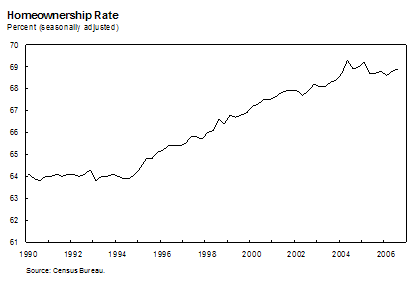
Young Students Show Academic Gains. According to the National Assessment of Educational Progress (NAEP), the achievement of young students has risen in recent years. In 2005, America's fourth graders posted the best reading and math scores in the test's history. For fourth graders, in reading there was more progress between 1999 and 2004 than in the previous 28 years combined. Eighth graders earned the highest math scores ever recorded for that grade by the NAEP. (National Center For Education Statistics)
College Tuition Remains An Affordable Investment. College enrollment rates among 18 to 19-year-olds increased by 6 percentage points from 2000 to 2005. 2005 marks the first year in which enrollment rates for this group passed 50 percent. Average net tuition and fees (accounting for grants) at four-year public universities was $2,700 for the 2006-07 academic year, and represented just 8 percent of income for families in the lowest income quartile. (National Center For Education Statistics, Census Bureau, and College Board)
